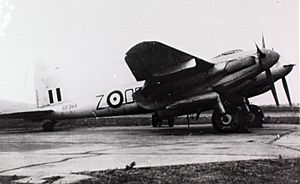Bryan Draper facts for kids
Quick facts for kids
Bryan Draper
|
|
|---|---|
| Born | 1916 Barry, South Wales |
| Died | 28 February 1945 (aged 28) |
| Allegiance | United Kingdom |
| Service/ |
Royal Air Force Volunteer Reserve |
| Rank | Squadron Leader |
| Unit | No. 45 Squadron No. 74 Squadron |
| Battles/wars | Second World War |
| Awards | Distinguished Flying Cross |
Bryan Vincent Draper (1916 – 1945) was a brave British pilot during World War II. He was known as a "flying ace." This means he shot down at least five enemy aircraft. Bryan was part of the Royal Air Force Volunteer Reserve (RAFVR). He joined in 1938 from Barry, South Wales.
When World War II began, he joined No. 74 Squadron. He flew in important battles like the Battle of France and the Battle of Britain. During these times, he destroyed several enemy planes. Later, he spent time teaching other pilots. In 1945, he returned to flying missions in India. Sadly, he died when his plane broke apart in the air.
Contents
Early Life and Joining the RAF
Bryan Vincent Draper was born in Barry, South Wales, in 1916. His parents were John and Nellie Draper. He went to Whitgift School in Croydon, London.
In April 1938, Bryan joined the Royal Air Force Volunteer Reserve. This was a group of people who trained to be pilots in their spare time. By late 1939, he had earned his "pilot's wings." This meant he was officially qualified to fly.
Flying in World War II
When World War II started, Bryan was called up for full-time service. He became a pilot officer in December 1939. After training to fly the fast Supermarine Spitfire fighter, he joined No. 74 Squadron. This was in February 1940.
His squadron helped protect British soldiers during Operation Dynamo. This was when soldiers were evacuated from Dunkirk. On May 24, he helped other pilots destroy a Dornier Do 17 bomber near Calais.
The Battle of Britain
After Dunkirk, Bryan's squadron fought in the Battle of Britain. This was a huge air battle over England. On July 10, he damaged a Messerschmitt Bf 109 fighter. Later that day, he also damaged a Do 17 bomber.
His squadron moved to different airfields. They were very busy stopping the Luftwaffe (German Air Force) from bombing London. On September 14, he shot down a Junkers Ju 88 bomber near Yarmouth. He also hit another Ju 88 over the English Channel.
In October, his squadron moved to Biggin Hill. On October 17, he shot down a Bf 109. The German pilot was captured. He also likely destroyed another Bf 109. Three days later, he probably destroyed another Bf 109 near Maidstone. His own Spitfire was hit and he had to crash-land.
On November 14, Bryan and his team attacked Junkers Ju 87 dive bombers over Deal. He shot down three of them! He also damaged a Bf 109. The next day, he destroyed another Bf 109 over Littlehampton.
Award and Instructor Duties
In December, Bryan was promoted to flying officer. He then went to a special course to learn how to be an instructor. The same month, he received the Distinguished Flying Cross. This was a very important award for bravery.
The official announcement said he had shown "great skill and determination." It also said he had destroyed seven enemy aircraft.
After his training, Bryan taught flying at the Royal Air Force College. He was promoted to flight lieutenant in March 1942. He also spent time teaching in Canada.
Service in the Far East
In December 1943, Bryan returned to England. He learned to fly the de Havilland Mosquito. This was a fast, twin-engined fighter-bomber.
At the start of 1945, he went back to flying missions. He joined No. 45 Squadron in India. His unit attacked Japanese targets during the campaign in Burma. On February 28, 1945, his plane broke apart during a mission. Bryan and his navigator were both killed.
Legacy
Bryan Draper was a squadron leader when he died. He was credited with shooting down six enemy aircraft. He also helped destroy another plane. He probably destroyed two more and damaged three others.
He is buried at Taukkyan War Cemetery in Rangoon, Myanmar. His name is also on a special plaque at Whitgift School. This plaque honors former students who flew in the Battle of Britain. It was put up in 2006.
Images for kids



